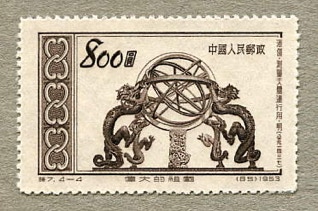China 1953 – Armillary sphere
Four ancient scientific instruments feature in a 1953 set from China. The only truly astronomical one is the armillary sphere shown on the last of them. This particular example was built in 1437 and still exists at Purple Mountain Observatory in Nanjing. It is a replica of a device used by the Chinese astronomer Guo Shoujing in the 13th century. At its simplest, an armillary sphere can be thought of as a skeletal version of a celestial globe. Rings represent the local north-south meridian, the horizon, the celestial equator, and the ecliptic, and the whole construction turns on an axis pointing to the north celestial pole (i.e. it is equatorially mounted). Another ring can be rotated to sight the positions of celestial objects. The name comes from the Latin word armilla meaning ‘ring’ or ‘bracelet’.
Two other members of the set have at least some passing interest for astronomers. The first stamp (SG no. 1601) shows an early form of magnetic compass, consisting of a small ladle composed of magnetite set upon a bronze plate inscribed with the 28 lunar mansions. A ladle was apparently chosen as a pointer to reflect the shape of the Big Dipper. The ladle’s handle actually points south, not north. The device dates from around 300 BC, in the Han Dynasty. This might arguably be considered an ‘astro’ subject were it not for the fact that such early devices were apparently used for divination rather than navigation or astronomy.
On the second stamp (SG 1602) is an early form of seismometer invented by the astronomer Zhang Heng, who is himself depicted on a Chinese stamp from 1955. Zhang’s seismometer, invented in AD 132 and also known as a seismoscope, consisted of a copper jar 6 ft across with eight ornamental dragons around the outside. When an earthquake occurred a ball fell out of the mouth of one of the dragons into the mouth of a toad below, making a noise. The direction of the earthquake could be ascertained from which dragon’s head the ball had dropped.
The third stamp in the set shows a distance-measuring device called a drum carriage in which a mechanical figure struck a drum to record each 500 m traversed.
SG number
Face value
Colour
1604
$800
Brown
